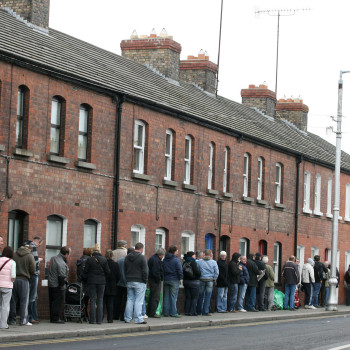Short memories could prove fatal!

With the ESRI/KBC Bank consumer confidence index at a nine-year high, it appears the dog days are at long last finally over for the Irish economy. However Dan White cautions that in the same way cash created by Ireland's property bubble evaporated overnight in 2008, now is not the time for the State to start spending with abandon
17 December 2015
After several years of disappointment, 2015 was the year that economic recovery finally dawned for the domestic economy. With the post-Celtic Tiger crash finally behind us, the challenge is to ensure that we don’t forget the lessons so expensively learned since 2008.
Ever since the Celtic Tiger bubble burst in mid-2008 our political leaders have been promising us that better times were just around the corner – who now remembers the late Brian Lenihan’s declaration in November 2009 that there was “light at the end of the tunnel” for the Irish economy? If there was it was from an oncoming express train!
Economic optimism flattened
Unfortunately for year after grinding year, such economic optimism failed to survive its first encounter with reality. It seemed inevitable that predictions of future economic growth would give way to the reality of actual stagnation the closer we got to the forecast period.
True, things stopped getting worse from about the first quarter of 2012 as unemployment finally peaked at over 15% and the number of people at work began to grow modestly once again. However, signs of renewed life – or at least a faint pulse – in the jobs market weren’t replicated elsewhere in the economy. Retailing and construction remained on the floor while average earnings stayed flat, indicating that employers will still be spoiled for choice when filling job vacancies.
Domestic doom
There were further signs of incipient recovery in 2013 and 2014 but the benefits seemed to be largely confined to the export sector. For anyone largely or exclusively dependent on the domestic economy conditions were still grim, as was evidenced by the very poor consumer confidence figures for most of this period. Only the revival of the Dublin housing market from mid-2013 onwards gave any hope that the recovery might eventually spread to the domestic economy in which most of us must earn a living.
With the benefit of hindsight, the domestic economy probably turned the corner some time in 2014 with the higher-than-expected jump in tax receipts that year allowing the government to end the run of austerity budgets stretching back to October 2008 a year early.
Recovery mode
However, it was in 2015 that the domestic economy decisively entered into recovery mode. The ESRI is now estimating growth in GNP (by far the best indicator of the performance of the domestic economy) of 5.9% for 2015 and is forecasting a further 4% growth in 2016.
This strong growth in the domestic economy is rapidly making itself felt. The November exchequer returns showed that tax receipts came in €3bn ahead of target for the first eleven months of 2015. Jobs growth has remained strong with the unemployment rate now down to under 9%. The fall in employment is finally improving workers’ bargaining power with average private sector earnings jumping by 3.6% in the 12 months to the third quarter of 2015.
Lower unemployment and higher earnings has in turn fed through into improved consumer confidence – with the ESRI/KBC Bank consumer confidence index now at a nine-year high. More optimistic consumers means that they are more willing to spend and the value of October retail sales was 2.4% higher than for the same month last year.
So let the good times roll and let’s party like it’s 2005 all over again!
Maybe, maybe not.
Dog days are over?
Things were never quite as bad as they seemed in the dog days of 2008-11. It could be argued that the death of the Celtic Tiger was at least partially the result of a series of unfortunate coincidences which combined to knock the stuffing out the Irish economy: soaring oil prices, a massively over-valued euro and the utterly insane attempts by the ECB to push up Eurozone interest rates in 2008 and 2011.
While nothing could have saved the over-borrowed Irish economy from a nasty downturn in 2008, this combination of factors turned a bog-standard recession into a once-in-a-century economic collapse.
By the same token, things are not quite as good as they seem now. For the past few years the Irish economy has been enjoying very favourable tailwinds. Interest rates are at record low levels, oil prices have collapsed and the value of the euro has sunk to much more competitive levels against both the dollar and sterling.
ECB interest rate increase
But, as happened after 2011, things can change quickly. The market turbulence that followed this month’s announcement of lower-than-expected intervention by the ECB almost certainly brings forward the date of an ECB interest rate increase – if not in late 2016 then certainly in the first half of 2017.
The prospect of an ECB interest rate increase will almost certainly push up the value of the euro against the dollar and sterling – which with the UK current account deficit at over 6% of GDP has its own problems.
And how much longer will oil prices stay low? I wouldn’t bet against some combination of Vladimir Putin/ISIS/Saudi Arabia provoking an incident in the Middle East that sends oil prices soaring once again.
How would the domestic economy respond to higher interest rates, a stronger exchange rate and dearer energy? Tourist numbers, over 8 million overseas visitors in 2015, would almost certainly fall as travelling to Ireland became more expensive and the cost of everything was higher for foreign tourists once they got here. Higher interest rates would dent consumer confidence and snuff out the housing market recovery while the price of Irish exports would rise in export markets.
Add it all up and it’s not difficult to predict that at the very least economic growth would slow considerably and might even go into reverse.
Omens are not good
Slower or no economic growth would almost certainly turn off the tap of higher-than-expected tax revenues. Of the €3bn tax overshoot in the first 11 months of 2015, €2.3bn or over three-quarters came from corporation tax. This is dangerously reminiscent of the Celtic Tiger era when the exchequer was raking in up to €10bn a year in property-related taxes.
It was great while it lasted but this revenue disappeared literally overnight when the property market collapsed in mid-2008. Will the same thing happen with corporation tax? With an election looming and politicians of all parties desperately seeking votes, the omens aren’t good. It seems as if our politicians are falling over themselves to find ways of spending what is almost certainly a once-off windfall caused by tighter international rules on how multinationals pay their taxes rather than a sustainable increase in revenues.
One can only hope that wiser counsel will prevail after the election. If it doesn’t then our forgetfulness could turn out to be very expensive sooner rather than later.



 Print
Print




Fans 0
Followers